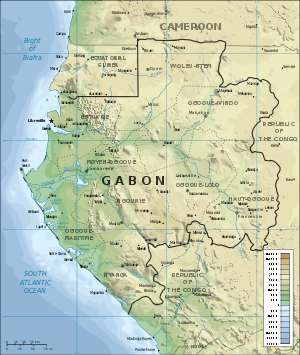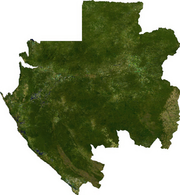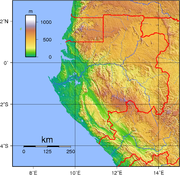
Geography of Gabon
About this schools Wikipedia selection
SOS Children offer a complete download of this selection for schools for use on schools intranets. SOS mothers each look after a a family of sponsored children.
| Continent | Africa |
| Geographic coordinates | 1°00′N 11°45′E |
| Area - Total - % water |
Ranked 74th 267,667 km² 3.7 % (10,000 km²) |
| Coastline | 885 km |
| Highest point | Mont Bengoué, 1070m at 00°57′21″N 13°41′09″E |
| Lowest point | Atlantic Ocean, 0 m |
| Longest river | Ogooué River |
| Largest inland body of water | ?? |
| Land Use - Arable land - Permanent crops - Permanent pastures - Forests and woodlands - Other |
1 % 1 % 18 % 77 % |
| Climate: | Tropical |
| Natural resources | Petroleum, manganese, uranium, gold, timber, iron ore, hydropower |
| Environmental issues | deforestation, poaching |
Gabon is a country in West Africa, lying along the Atlantic Ocean, just south of the Bight of Biafra.
Borders
Gabon has a total of 2,551 km of international boundaries. It borders Equatorial Guinea (350 km) and Cameroon (298 km) to the north and the Republic of the Congo (1,903 km) to the west and south. Gabon lies on the equator.
- Maritime claims
-
- Contiguous zone: 24 nmi (44 km)
- Exclusive economic zone: 200 nmi (370 km)
- Territorial sea: 12 nmi (22 km)
Climate
Gabon has the moist, hot climate typical of tropical regions. The hottest month is January, with an average high at Libreville of 31 °C (88 °F) and an average low of 23 °C (73 °F). Average July temperatures in the capital range between 20 and 28 °C (68 and 82 °F). From June to September there is virtually no rain but high humidity; there is occasional rain in December and January. During the remaining months, rainfall is heavy. The excessive rainfall is caused by the condensation of moist air resulting from the meeting, directly off the coast, of the cold Benguela Current from the south and the warm Guinea Current from the north. At Libreville, the average annual rainfall is more than 2,540 mm (100 in). Farther north on the coast, it is 3,810 mm (150 in).
Terrain
Narrow coastal plain with patches of Central African mangroves; hilly interior; savanna in east and south.
- Irrigated land: 40 km² (1993 est.)
Environment
International agreements:
Party to: Biodiversity, Climate Change, Desertification, Endangered Species, Law of the Sea, Marine Dumping, Nuclear Test Ban, Ozone Layer Protection, Ship Pollution, Tropical Timber 83, Tropical Timber 94, Wetlands, International Convention for the Regulation of Whaling
Signed, but not ratified: None of the selected agreements
Other
- Natural hazards
- NA
|
|||||||||||
|
|||||||||||
|
||||||||||||||||||||||||||||||||||||




